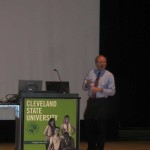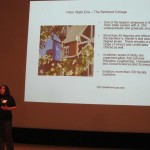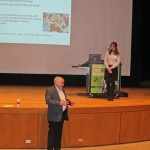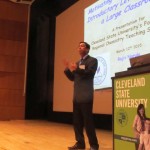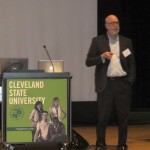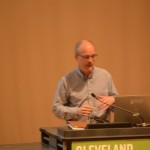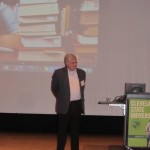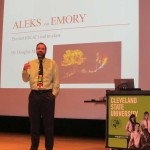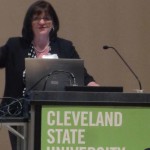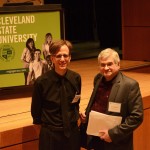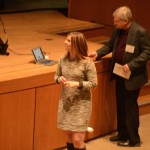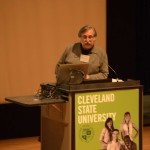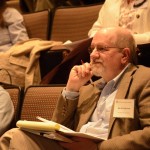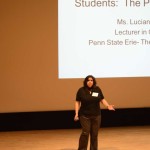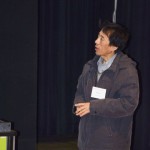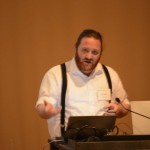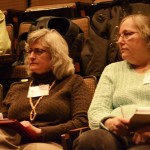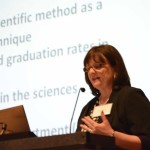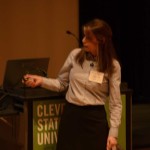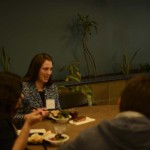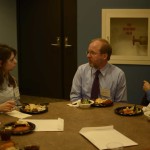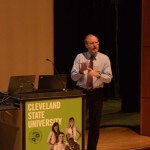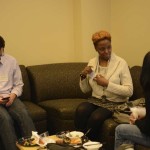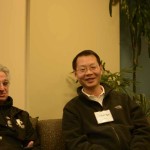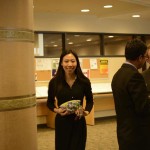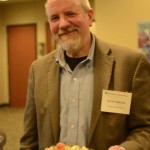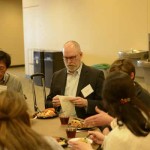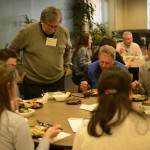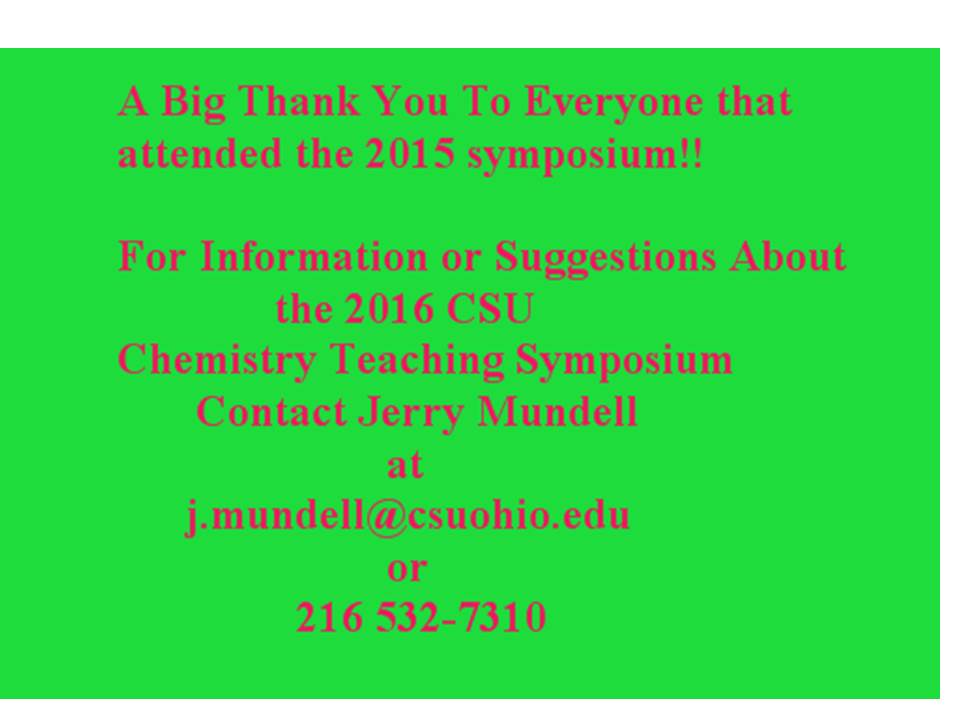The General Chemistry Teaching Symposium was held on March 13-15 2014 at Cleveland State University. Please click on a link below to see Abstracts of the presentations/posters, the Event Schedule, and the Photo Gallery.
Symposium Abstracts
Symposium Schedule of Events
Photo Gallery
Information on 2016 Symposium
Abstracts
Jesse Reich
21st Century Technology Infused Classrooms
100 years ago classrooms were revolutionized by textbooks and the speed with which information could be accessed. The same thing happened again a few decades ago as the internet allowed learners to access information at the click of a button for free. Today’s students no longer struggle finding chemistry content; instead the limiting reagent in their progress appears to be applying content to problem solving. Many tools and approaches exist for professors to help students learn and to assess their progress. Here we discuss a variety of tools and investigate their efficacy.
Danae Quirk Dorr
Building from Investment: Using the Flipped Classroom Model to Fuel Higher Level Learning
Implementation of the “Flipped Classroom” instructional model coupled with various online learning resources drove student motivation and promoted accountability in this allied health chemistry course taught at Minnesota State University, Mankato. Once charged with specific learning goals, students obtained the requisite knowledge from online recordings (Tegrity) and interactive online activities (LearnSmart and SmartBook). Student engagement was enhanced by employing in-class active learning strategies. Student learning was regularly assessed using online homework (Connect) as well as in-class through the use of clickers, unit quizzes, and the ACS standardized exam.
George Kemper and Paul Orman
The Next Generation of Teaching Labs
Student needs and learning styles are evolving, and teaching the resolution of real-world problems poses challenges to the traditional laboratory. Many institutions have not changed the traditional laboratory design, but can it be improved? This presentation will examine the forces driving the design of future of laboratory environments in the undergraduate experience and potential outcomes for future design consideration.
Doug Mulford
ALEKS and the GCAT at Emory: Design and implementation
This talk will focus on the use of ALEKS for a summer pre-test and remediation at Emory Universality in addition to implementation throughout the year. We have found ALEKS to be very effective at helping students be ready for college chemistry on day 1 regardless of their background training. In addition we have found the in-class implementation has fundamentally changed the course with student learning greatly increased even for the weakest students.
Michelle Driessen
Meeting the Needs of Digital Natives
Our students are more digitally inclined than ever. This can be used to our advantage to make the learning process more transparent and flexible. Tips and ideas gathered from teaching a successful online introductory chemistry course and a reduced-seat-time blended general chemistry sequence will be discussed.
David Spurgeon
What if…? The Changing Face of Higher Education
The digital environment does more than provide a place to do homework. We explore ways to control college costs, reimagine the textbook, and provide an effective learning experience for students.
Haidy Kamel
Addressing the Achievement Gap: Engaging Students in the Chemistry Classroom
College classrooms exhibit a diverse student population with different academic backgrounds. One of the challenges in the chemistry classroom is the achievement gap between the highperforming and the academically struggling students. A variety of instructional strategies and classroom engaging practices are used to facilitate the academic success of all students. These include student-centered learning experiences such as in-class demonstrations, cartoons, games and more. The materials in this presentation come primarily from personal practices and academic articles.
Rajiv Narula
Motivating a Diverse Group of Introductory Level Students in a Large Classroom
Being an educator is not easy! One constantly struggles with a diverse group of students, some who are highly motivated, others who are not. The challenge is greater in a large introductory level course & the situation worsens if that course is Chemistry. How does one effectively teach facing these challenges? In my experience the best way is to connect to students the very first day. My first lecture incorporates effective techniques that I have learned in my own continuing education coursework. The results are phenomenal. My first lecture changes the “climate” of the classroom setting students up for success.
Luciana Aronne
Working with High School Students, The Pros and Cons
For the past eight years there has been a pedagogical collaboration between the chemistry department at Penn State Erie- The Behrend College and Collegiate Academy, an urban college preparatory school in Erie, PA. The goal of this collaboration is to have students work with a faculty member on developing new laboratory experiments for the first year general chemistry laboratory curriculum sequence at Penn State Erie- The Behrend College. This talk will discuss the advantages and disadvantages of working with high school students in a college setting.
Dr. Zhihai Li
Effective Large Classroom Teaching at a Primarily Teaching Institution
It is always a challenge to effectively teach in a large classroom at a primarily teaching institution, especially when you are a new faculty and teach students having very different background and pre-knowledge. In this presentation, we will discuss how to teach a university core course (General Chemistry) to more than one hundred students who come from different departments/majors and having different level of chemistry pre-knowledge and distinct cultural background using multiple approaches and strategies.
Regan Silvestri
Magical Science: Chemistry Magic Tricks Just for Fun!
Chemistry magic tricks are simply chemistry demonstrations cleverly performed, and are highly valuable for engaging and motivating students in the study of chemistry. Our agenda has been to adapt common chemistry demonstrations into presentations with clever twists, essentially turning them into magic tricks. This workshop will show how a science demonstration can be turned into a science magic trick simply by adapting the presentation. Science magic tricks provide a unique forum not only for expanding scientific knowledge, but moreover scientific interest. Our hope is that students will be engaged and motivated in the future study of chemistry.
Chris Bowers
High School Chemistry Teacher Workshop
In June 2015 Ohio Northern University’s Department of Chemistry and Biochemistry will hosted its 5th annual High School Chemistry Teacher Workshop. The workshop is a weeklong residential workshop with a primary focus on laboratory activities and is held on ONU’s campus. The participating teachers work with ONU faculty mentors to develop a personalized plan and set of goals related to participation in the workshop. This plan is developed prior to their attendance at the weeklong workshop to allow for maximum productivity during the lab portions of the program. The workshop program involves a mixture of various professional development activities including training on the use of probeware, lab exercise testing and development, discussions of laboratory safety, the challenges of teaching chemistry and the use of chemical demonstrations in the classroom. Each teacher receives one probeware unit for use at their school. In addition sets of probeware units are available to be rotated among the teacher participants during the following school year. The faculty mentors perform follow-up classroom visits to observe the implementation of lab exercises developed at the workshop.
Mark R. Watry
Improving Scientific Thinking and Writing in the General Chemistry Laboratory
We use many guided inquiry laboratory exercises and focus on making predictions (hypotheses) formulating molecular scale models, and reformulating the hypotheses and models as we collect data that test the initial hypotheses and models. The students keep a “formal” laboratory notebook. Almost every experiment requires the student to formulate a hypothesis that can be tested in the experiments we will perform. Questions at the end of each experiment suggest the items that should be included in a scientific discussion of the results. Over the course of the first semester we guide them through the process of keeping a good notebook and writing a complete report sans discussion. In the second semester we include discussions of the results and error analysis. Most experiments are conducted before the material comes up in lecture, and we see that the students are better prepared to benefit from the lecture. The students are also seen as better prepared for their subsequent science courses, whatever discipline they are in.
Anne O’Connor
Research Experience to Enhance Learning: REEL Chemistry Laboratory
In contrast to traditional chemistry lab courses where students perform lab exercises and submit lab reports with a known outcome, the approach of the REEL method of lab teaching is to have students, work independently and collaboratively, develop, pursue and implement their own research projects. Since most of these students lack any sort of research background, guidance and instruction that include literature searches, instrument instruction, data acquisition, data analysis, and presentation of research results are provided for each of the projects. By the end of the semester, each group of students present a poster of their research at a conference that exhibits both graduate and undergraduate research or at a regional American Chemical Society (ACS) meeting. The original research of students regarding such topics as arsenic and chromium content in wooden playground structures, tricolasan and phathalates in cosmetics, shampoos and other personal products, bioremediation of PAHs by plants and mushrooms, heavy metal concentrations in community gardens and brown field sites around the Cleveland area, lead concentrations in the vicinity of roadways, and the occurrence of polycyclic aromatic hydrocarbons (PAHs) in cooked foods, sealed coated parking lots, and motor oils as well as the toxicity of PAHs and heavy metals on plants and bacteria are presented. Instructing a REEL lab takes full commitment from both instructors and teaching assistants. Instead of a single traditional lab exercise each week, the activities of the REEL labs keep the instructor and two teaching assistants very busy. In the REEL labs, students quickly learn the importance of teamwork and collaboration. They develop critical and creative thinking that builds confidence as well as knowledge–all valuable skills in today’s areas of research. Since these are original research ideas the students take ownership of their projects. In a traditional lab course the “experiments” are usually exercises with known outcomes. In REEL lab, since students are working on actual research projects, the outcomes are unknown. This provides the students with a sense of engagement, discovery and knowledge.
Anne O’Connor
Creating Teaching Videos and Other Supplemental Materials
Workshop will focus on the production of instructional videos and other online support for students. Programs such as Camtasia Studio, Smoothdraw, iSpring Quiz Creator, and Adobe Professional in conjunction with a bamboo tablet and microphone are used to easily create supplemental materials for students./p
Salah Blaih
An Interactive Community: A Student-Centered Strategy for Team-Based Laboratory Engagement
In keeping with current trends in chemical education, our chemistry lab program emphasizes the following goals: 1) combining some of the traditional verification experiments with active learning/guided inquiry application labs, 2) providing opportunities for group work, and 3) emphasizing technical report writing by the students. These goals are geared toward students’ future success in the work environment.
Team-based laboratory projects will be discussed. Students work in small groups with individual roles to ensure that all students are fully engaged in the learning process. The concept of Process Oriented Guided Inquiry Learning (POGIL) is utilized. Students seek to learn content, acquire key process skills, and effectively apply critical thinking through communications and construction of their own understanding. A project dealing with recycling of plastic, where students explore a possible scenario of separating a mixture of plastic chips based on density difference will be discussed. Another project dealing with softening of hard water and determination of degree of hardness will be discussed. An assessment survey and student’s responses for these projects are also shown
.
Ghaffari Shahrokh
Investigating the Relationship Between Student Performance and Average Time Spent on Chemistry Exams
During an examination period, one can find students who take noticeably less time than average to complete the exam, as well as students who require more time than average to finish the exam. This study examined these two groups of students to answer the following:
1) Is the amount of time that a student spends taking an exam a habit?
2) Is there any correlation between examination scores and the length of time it took to complete the exam?
The results of the study answered both of the above questions. In response to the first question, of the students who took either more or less than the average examination time to complete their exam, twenty-five or higher percent were the same students each time. As these particular students demonstrated a consistent pattern in how long it took them to finish from one exam period to the next, the results indicate that the time spent taking an exam is due to habit, where habit is defined as “A settled tendency or usual manner of behavior” (1). In response to the second question, the study shows that no significant and consistence correlation exists between examination score and the length of time it took to complete the exam.
Lynne Divis(Poster)
How Pop-able are Popcorn Kernels? A Supplement to a Density Experiment for General, Organic, and Biological (GOB) Chemistry Students
The number of kernels that pop and the size of the resulting popped kernels depend on the density of the unpopped kernels, which, in turn, depends on the moisture content of the kernels. After performing typical density measurements on both solids and liquids, students decide which method to use for analyzing their popcorn kernel samples. Students carry out their chosen method, calculate the density of their kernels, interpret a graph of percent moisture versus density, and draw conclusions regarding the “pop-ability” of their kernels. The activity and sample data will be presented, and comments will be welcome.
Back to Top of Page
Symposium Abstracts
Symposium Schedule of Events
Photo Gallery
SCHEDULE OF EVENTS
Thursday, March 12
8:00 AM-8:50 AM
Registration an Continental Breakfast of Coffee.
Juice, Fruit, and Pastry
Location: Main Classroom Atrium
Morning Sessions
Location: Main Classroom Auditorium
9:00 – 9:05 AM
Welcome Remarks: Meredith Bond, Dean of College of Science and Health Professions
David Ball, Chair Chemistry Department of Chemistry
9:05 – 9:45 AM
David Spurgeon, Director of Chemistry, McGraw Hill, What if…? The Changing Face of Higher Education Publishing
10:00 – 10:30 AM
Rajiv Narula, SUNY College of Technology at Canton, One Year On – Motivating a Diverse Group of Intgroductory Level Students in a Large Classroom>
10:40 – 11:10 AM
Doug Mulford, Emory University, ALEKS and the GCAT at Emory: Design and Implementation
11:20 – 12:00 AM
Heidi Kamel, Cuyahoga Community College, Addressing the Achievement Gap: Engaging Students in the Chemistry Classroom
Lunch served in Main Classroom Atrium
12:00 – 1:20 PM
Afternoon Sessions
Location: Main Classroom Auditorium
1:30 – 2:00 PM
Luciana Aronne, Penn State, Erie, The Behrend College, Working with High School Students: The Pros and the Cons
2:10 – 2:40 PM
Mark Watry, Franciscan University of Steubenville, Improving Scientific Thinking and Writing and the General Chemistry Laboratory.
2:50 – 3:20 PM
Anne O’Connor, Cleveland State University, Research Experiences to Enhance Learning, REEL Chemistry
3:30 – 4:00 PM
Ghaffari Shahrokh, Ohio University, Investigating the Relationship Between Student Performance and the Average Time Spent on Chemistry Examinations
4:10 – 4:50 PM
Open Panel Discussion, Jerry Mundell, Cleveland State University, Danae Quirk Dorr, Minnesota State University, Mankato, Anne O’Connor, Cleveland State University Today’s Challenges in Teaching Chemistry
5:00 – 7:00 PM
Wine and Punch Social
All attendees are invited to relax and enjoy wine, punch, and hors d’oeuvres during the poster session
Location: Main Classroom Atrium
Friday, March 13
8:00 AM – 10:00 AM
Registration and Continental Breakfast of Coffee, Juice, Fruit, and Pastry
Location: Main Classroom Atrium
8:30 – 9:50
Workshops:
Anne O’Connor, Cleveland State University, Teaching Technologies 101: How to Create Teaching Videos and Other Digital Supplemental Materials.
Location: MC 101
Danae Quirk Dorr, Minnesota State University, Mankato Building from Investment: Using the Flipped Classroom Model to Find Higher Level Learning
Location: MC 103, Main Classroom
Doug Mulford, Emory University, Using ALEKS
Location: MC 104, Main Classroom Building
Morning Presentations
Location: Main Classroom Atrium
10:00 – 10:45 AM
Jesse Reich, National Learning Solutions Scientist, Sapling Learning, 21st Century Technology Infused Classrooms
11:00 – 11:45 AM
George Kemper and Paul Orban, BHDP, The Next Generation of Teaching Labs
12:00 – 1:00 PM
Lunch served in Main Classroom Atrium
Afternoon Sessions
Location: Main Classroom Auditorium
12:45 – 1:20 PM
Regan Silvestri, Lorain County Community College, Chemistry Magic Tricks Just for Fun
12:45 – 1:20PM
George Kemper, Paul Orban, and Jerry Mundell, Tour of New Freshman Teaching Laboratories
1:30 – 2:00PM
Michelle Driessen, University of Minnesota, Minneapolis Meeting the Needs of Digital Natives
2:10 – 2:40 PM
Zhihai Li, Ball State University, Effective Large Classroom Teaching at a Primarily Teaching University
3:00 – 3:30 PM
Chris Bowers, Ohio Northern UniversityHigh School Chemistry Teacher Workshop
3:40 – 4:00 PM
Salah Blaih, Kent State University, Trunball, An Interactive Community: A Student-Centered Strategy for Team-Based Laboratory Engagement
4:10 – 4:30 PM
Open Forum: Symposium Review and Closing Remarks.
Back to Top of Page
Symposium Abstracts
Symposium Schedule of Events
Photo Gallery
Photo Gallery
Please click on a photo to view the gallery Slide Show. Enjoy!!
To exit the slideshow, please click “Close Slideshow” in the upper left hand corner.
Back to Top of Page
Symposium Abstracts
Symposium Schedule of Events
Photo Gallery
2016 Symposium
Back to Top of Page
Symposium Abstracts
Symposium Schedule of Events
Photo Gallery

